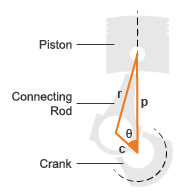Piston
Piston mechanism of reciprocating combustion engine
Libraries:
Simscape /
Driveline /
Engines & Motors
Description
The Piston block represents the piston mechanism of a reciprocating combustion engine. The Piston block accounts for the instantaneous torque transmitted to the engine crankshaft, which enables you to simulate vibrations in the drivetrain due to piston revolution. To model a multi-piston engine, use the Piston Engine block.
Port B represents a piston container such as an engine block and port F represents the rotating crankshaft. The piston force follows from the cylinder pressure and cross-sectional area. The block obtains the combustion pressure from a lookup table parameterized in terms of the crank angle and, optionally, the crank angular velocity and engine throttle level.
The crank torque follows from the piston force and crank angle, the crank and connecting rod lengths. In terms of these inputs, the ratio of the piston force and crank torque is
where:
FB is the instantaneous piston force associated with the base port.
TF is the instantaneous crank torque associated with the follower port.
c is the crank length.
θ is the instantaneous crank angle.
r is the connecting rod length.
Piston Dimensions

Port T lets you specify the engine throttle level as a fraction between 0 and 1. This fraction corresponds to the percentage of full power generated. The block uses the data at point T whenever the pressure lookup table in the block property inspector is parameterized only in terms of the crank angle.
Ports
Input
Output
Conserving
Parameters
Extended Capabilities
Version History
Introduced in R2016a
